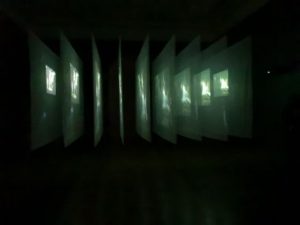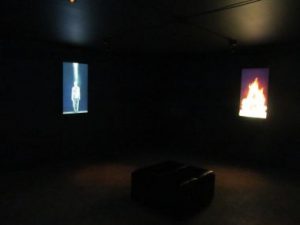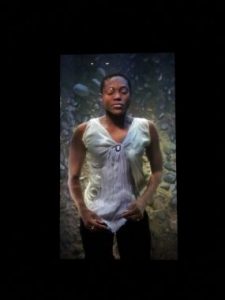Bill Viola is internationally known as the father of video art. Dealing with the main themes human experience, such as birth, death and time, in relation with new audio-video technologies.

Image source: https://le-citazioni.it/autori/bill-viola/?o=new
About his life
Bill Viola was born on February 25, 1951 in New York. In 1973 he graduated at the College of Visual and Performing Arts at the Syracuse University of New York. From 1974 to 1976 he was in Florence, Italy, where he became the technical director of Art/Tapes/22, an indipendent art video production facility and had the opportunity to meet some famous artists as Bruce Nauman and Nam June Paik. In 1977 Viola was invited by the cultural arts diretor Kira Perov to show his works at the Trobe University of Melbourn, Australia. Three years later Perov and Viola married and moved to Japan, where they worked with the Japan/U.S Fellowship and studied Buddhism with Zen master Daien Tanaka. During this period Bill Viola took part at Sony Corporation’s Atsugi Laboratories. In 1998 is invited as a scholar-in-residence at the Getty Research Institute in Los Angeles, later he creates a series of three videos for the rock group Nine Inch Nails. Now Bill Viola and Kira Perov live in Long Beach, California.

Image source: https://www.flickr.com/photos/acme_/47276751641/
Viola’s style
Viola’s works are characterized by Classical Renaissance art, Oriental art, Zen Buddhism, Islamic Sufism and Christian Mysticism. Music has an important role in his works, such as the use of the slow motion technic and the use of futuristic technologies. Viola’s art deals with the central theme of the universal human experience – birth, death and the flow of time. Even the water is a central and recurring elements in his works. In his video, Bill Viola is often the leading actor and looks like a real performer, other times, the protagonists are actors which are directed by the artist like in a movie set. In Viola’s video installation, the most attractive aspect is the capacity of join two realities, which are appareantly the opposite, but almost connected: the human and the digital one.

Image source: https://www.flickr.com/photos/rocor/29993101241/
Awards and recognition
Viola has received many international awards and recognitions, the most importants are: John T. and Catherine D. MacArthur Foundation Fellowship (1989); Medienkunstpreis, presented by Zentrum für Kunst und Medientechnologie, Karlsruhe, and Siemens Kulturprogramm, in Germany (1993). Viola’s received the honorary degree from: University of Siracusa (1995), The School of the Art Institute of Chicago (1997), California Institute of the Arts (2000), and Royal College of Art, London (2004) and many others. In 2006 he was awarded Commander of the Order of Arts and Letters by the French Government. In 2009 he received the XXI Catalonia International Prize in Barcelona, Spain and was awarded the Japan Art Association’s Praemiun Imperiale art award in the category of painting in 2011. Viola was elected an Honorary Royal Academician in 2017.

Image source: https://www.flickr.com/photos/westher/13877550004
Most famous works
- Information, 1973. This is one of the Viola’s first works, and is an early investigation of the material presence of the electronic medium.
- Il Vapore, 1975, is an installation in which Bill Viola brings together video, performance and public participation.
- He Weeps for You, 1976, one of the firs video installations.
- Migration, 1976;
- The Tree of Life, 1977;
- Chott el-Djerid (A Portait in Light and Heat), 1979. Almost captures the optical and acoustic distortions of nature.
- Hatsu Yume (First Dream), 1981. Viola fuses his personal observation of Japanese culture with a metaphysical contemplation of life.
- Reason for Knocking at an Empty House, 1982. This installation is dedicated to the memorial of Phineas P. Gage.
- Room for St. John of the Cross, 1983. St. John of the Cross was a spanish mystical poet held captive for nine months in 1577 by religious power.
- Science of the Heart, 1983;
- Anthem, 1983. This work is considered as a ritual evocation of our deepest primal fears and the separation of body and spirit.
- The Theatre of Memory, 1985;
- Heaven and Hell, 1985;
- The Greeting, 1995. Viola took the inspiration from Jacomo da Pontormo‘s painting The Visitation (1528-29).
- Viola’s other work included a production of Richard Wagner’s Tristan and Isolde which he collaborated on with Perov, avant-garde director Peter Sellar, and conductor Esa-Pekka Salonen, it premiered in 2005.

Image source: https://www.flickr.com/photos/centralasian/8300101701
Info sources:
https://www.britannica.com/biography/Bill-Viola
https://www.billviola.com/biograph.htm
https://en.wikipedia.org/wiki/Bill_Viola
http://www.eai.org/artists/bill-viola/biography https://www.eai.org/
